Which Of The Following Animals Travels In A Circular Migration According
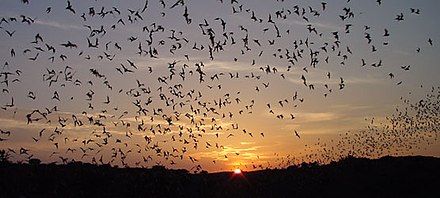
Animal migration is the relatively long-altitude motility of private animals, normally on a seasonal basis. It is the virtually mutual form of migration in ecology. Information technology is plant in all major animal groups, including birds, mammals, fish, reptiles, amphibians, insects, and crustaceans. The cause of migration may exist local climate, local availability of food, the flavour of the year or for mating.
To be counted as a true migration, and not just a local dispersal or irruption, the movement of the animals should be an annual or seasonal occurrence, or a major habitat modify equally part of their life. An annual issue could include Northern Hemisphere birds migrating south for the winter, or wildebeest migrating annually for seasonal grazing. A major habitat change could include young Atlantic salmon or sea lamprey leaving the river of their birth when they have reached a few inches in size. Some traditional forms of human migration fit this pattern.
Migrations can be studied using traditional identification tags such as bird rings, or tracked directly with electronic tracking devices. Earlier animal migration was understood, sociology explanations were formulated for the appearance and disappearance of some species, such as that barnacle geese grew from goose barnacles.
Overview [edit]
Concepts [edit]

Migration can take very different forms in different species, and has a multifariousness of causes.[1] [ii] [3] As such, at that place is no simple accepted definition of migration.[iv] One of the most unremarkably used definitions, proposed by the zoologist J. S. Kennedy[5] is
Migratory beliefs is persistent and straightened-out movement effected by the animal's own locomotory exertions or by its active embarkation on a vehicle. It depends on some temporary inhibition of station-keeping responses, but promotes their eventual disinhibition and recurrence.[five]
Migration encompasses iv related concepts: persistent direct movement; relocation of an individual on a greater scale (in both space and time) than its normal daily activities; seasonal to-and-fro motion of a population betwixt two areas; and movement leading to the redistribution of individuals within a population.[four] Migration can be either obligate, meaning individuals must drift, or facultative, meaning individuals can "cull" to migrate or not. Within a migratory species or even inside a single population, oft not all individuals drift. Consummate migration is when all individuals migrate, partial migration is when some individuals migrate while others do non, and differential migration is when the difference between migratory and non-migratory individuals is based on discernible characteristics similar age or sex activity.[4] Irregular (non-cyclical) migrations such as irruptions can occur under pressure of famine, overpopulation of a locality, or some more obscure influence.[6]
Seasonal [edit]
Seasonal migration is the motion of various species from one habitat to some other during the yr. Resource availability changes depending on seasonal fluctuations, which influence migration patterns. Some species such equally Pacific salmon migrate to reproduce; every twelvemonth, they swim upstream to mate and then render to the body of water.[seven] Temperature is a driving factor of migration that is dependent on the time of yr. Many species, specially birds, migrate to warmer locations during the winter to escape poor ecology atmospheric condition.[8]
Circadian [edit]
Circadian migration is where birds utilize circadian rhythm (CR) to regulate migration in both autumn and jump. In circadian migration, clocks of both circadian (daily) and circannual (annual) patterns are used to make up one's mind the birds' orientation in both time and space every bit they migrate from ane destination to the next. This blazon of migration is advantageous in birds that, during the winter, remain close to the equator, and also allows the monitoring of the auditory and spatial retentiveness of the bird'southward brain to remember an optimal site of migration. These birds likewise have timing mechanisms that provide them with the distance to their destination.[9]
Tidal [edit]
Tidal migration is the use of tides by organisms to motion periodically from i habitat to some other. This blazon of migration is ofttimes used in order to notice nutrient or mates. Tides can comport organisms horizontally and vertically for equally little as a few nanometres to fifty-fifty thousands of kilometres.[ten] The most mutual course of tidal migration is to and from the intertidal zone during daily tidal cycles.[x] These zones are oftentimes populated by many different species and are rich in nutrients. Organisms like crabs, nematodes, and small fish move in and out of these areas equally the tides rising and fall, typically about every twelve hours. The cycle movements are associated with foraging of marine and bird species. Typically, during low tide, smaller or younger species will sally to forage because they can survive in the shallower water and accept less chance of existence preyed upon. During high tide, larger species can exist found due to the deeper water and nutrient upwelling from the tidal movements. Tidal migration is often facilitated past sea currents.[11] [12] [13]
Diel [edit]
While most migratory movements occur on an annual bike, some daily movements are also described as migration. Many aquatic animals make a diel vertical migration, travelling a few hundred metres up and down the h2o column,[fourteen] while some jellyfish brand daily horizontal migrations of a few hundred metres.[15]
In specific groups [edit]
Different kinds of animals migrate in different ways.
In birds [edit]
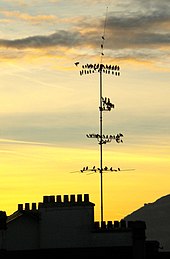
Flocks of birds assembling earlier migration southwards
Approximately 1,800 of the world'southward 10,000 bird species migrate long distances each year in response to the seasons.[16] Many of these migrations are north-due south, with species feeding and breeding in loftier northern latitudes in the summer and moving some hundreds of kilometres south for the winter.[17] Some species extend this strategy to migrate annually betwixt the Northern and Southern Hemispheres. The Chill tern has the longest migration journeying of whatsoever bird: it flies from its Chill breeding grounds to the Antarctic and dorsum once again each year, a distance of at least xix,000 km (12,000 mi), giving it two summers every twelvemonth.[18]
Bird migration is controlled primarily by day length, signalled by hormonal changes in the bird's body.[nineteen] On migration, birds navigate using multiple senses. Many birds utilise a sun compass, requiring them to compensate for the sun's changing position with time of 24-hour interval.[20] Navigation involves the ability to discover magnetic fields.[21]
In fish [edit]

Most fish species are relatively limited in their movements, remaining in a unmarried geographical expanse and making short migrations to overwinter, to spawn, or to feed. A few hundred species migrate long distances, in some cases of thousands of kilometres. About 120 species of fish, including several species of salmon, drift between saltwater and freshwater (they are 'diadromous').[22] [23]
Provender fish such as herring and capelin migrate around substantial parts of the N Atlantic ocean. The capelin, for example, spawn around the southern and western coasts of Iceland; their larvae migrate clockwise effectually Republic of iceland, while the fish swim northwards towards Jan Mayen island to feed and return to Iceland parallel with Greenland's eastward coast.[24]
In the 'sardine run', billions of Southern African pilchard Sardinops sagax spawn in the cold waters of the Agulhas Bank and movement northward along the east declension of Southward Africa between May and July.[25]
In insects [edit]
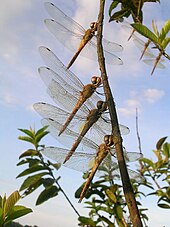
Some winged insects such as locusts and certain butterflies and dragonflies with strong flying migrate long distances. Amongst the dragonflies, species of Libellula and Sympetrum are known for mass migration, while Pantala flavescens, known as the globe skimmer or wandering glider dragonfly, makes the longest ocean crossing of whatever insect: between Bharat and Africa.[26] Exceptionally, swarms of the desert locust, Schistocerca gregaria, flew westwards across the Atlantic Ocean for iv,500 kilometres (2,800 mi) during October 1988, using air currents in the Inter-Tropical Convergence Zone.[27]
In some migratory collywobbles, such as the monarch butterfly and the painted lady, no individual completes the whole migration. Instead, the butterflies mate and reproduce on the journey, and successive generations continue the migration.[28]
In mammals [edit]
Some mammals undertake exceptional migrations; reindeer have ane of the longest terrestrial migrations on the planet, reaching as much equally 4,868 kilometres (three,025 mi) per twelvemonth in North America. Nevertheless, over the grade of a year, grey wolves move the most. 1 grey wolf covered a full cumulative annual distance of 7,247 kilometres (four,503 mi).[29]

Mass migration occurs in mammals such equally the Serengeti 'smashing migration', an almanac circular pattern of movement with some one.seven million wildebeest and hundreds of thousands of other large game animals, including gazelles and zebra.[30] [31] More than than 20 such species engage, or used to engage, in mass migrations.[32] Of these migrations, those of the springbok, blackness wildebeest, blesbok, scimitar-horned oryx, and kulan have ceased.[33] Long-distance migrations occur in some bats – notably the mass migration of the Mexican free-tailed bat between Oregon and southern Mexico.[34] Migration is of import in cetaceans, including whales, dolphins and porpoises; some species travel long distances between their feeding and their convenance areas.[35]
Humans are mammals, but human migration, as commonly defined, is when individuals often permanently alter where they live, which does not fit the patterns described here. An exception is some traditional migratory patterns such as transhumance, in which herders and their animals move seasonally betwixt mountains and valleys, and the seasonal movements of nomads.[36] [37]
In other animals [edit]
Among the reptiles, adult sea turtles drift long distances to breed, as do some amphibians. Hatchling sea turtles, likewise, emerge from hugger-mugger nests, crawl downward to the water, and swim offshore to reach the open body of water.[38] Juvenile green sea turtles brand use of Globe's magnetic field to navigate.[39]
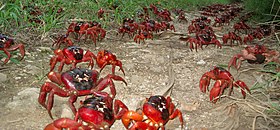
Some crustaceans migrate, such as the largely-terrestrial Christmas Island red crab, which moves en masse each twelvemonth by the millions. Similar other crabs, they breathe using gills, which must remain moisture, and so they avoid direct sunlight, digging burrows to shelter from the dominicus. They mate on land near their burrows. The females incubate their eggs in their intestinal brood pouches for 2 weeks. They and then return to the sea to release their eggs at high tide in the moon'due south final quarter. The larvae spend a few weeks at sea and then return to state.[xl] [41]
Tracking migration [edit]
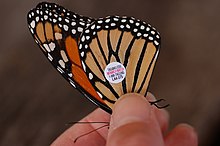
A migratory butterfly, a monarch, tagged for identification
Scientists gather observations of animal migration by tracking their movements. Animals were traditionally tracked with identification tags such as bird rings for later recovery. Notwithstanding, no information was obtained about the actual road followed between release and recovery, and only a fraction of tagged individuals were recovered. More convenient, therefore, are electronic devices such as radio-tracking collars that can be followed by radio, whether handheld, in a vehicle or shipping, or by satellite.[42] GPS animal tracking enables accurate positions to be circulate at regular intervals, simply the devices are inevitably heavier and more expensive than those without GPS. An alternative is the Argos Doppler tag, also called a 'Platform Transmitter Terminal' (PTT), which sends regularly to the polar-orbiting Argos satellites; using Doppler shift, the animal'south location can be estimated, relatively roughly compared to GPS, merely at a lower cost and weight.[42] A technology suitable for small birds which cannot conduct the heavier devices is the geolocator which logs the light level as the bird flies, for assay on recapture.[43] In that location is scope for further development of systems able to track small animals globally.[44]
Radio-tracking tags tin can be fitted to insects, including dragonflies and bees.[45]
In culture [edit]
Before animal migration was understood, diverse sociology and erroneous explanations were formulated to account for the disappearance or sudden arrival of birds in an area. In Ancient Hellenic republic, Aristotle proposed that robins turned into redstarts when summertime arrived.[46] The barnacle goose was explained in European Medieval bestiaries and manuscripts as either growing like fruit on trees, or developing from goose barnacles on pieces of driftwood.[47] Some other example is the swallow, which was one time thought, even by naturalists such as Gilbert White, to hibernate either underwater, buried in muddy riverbanks, or in hollow trees.[48]
See also [edit]
- Great American Interchange
References [edit]
- ^ Attenborough, David (1990). The Trials of Life. London: Collins/BBCBooks. p. 123. ISBN978-0-00-219940-7.
- ^ Silva, S.; Servia, K. J.; Vieira-Lanero, R.; Cobo, F. (2012). "Downstream migration and hematophagous feeding of newly metamorphosed sea lampreys (Petromyzon marinus Linnaeus, 1758)". Hydrobiologia. 700 (1): 277–286. doi:10.1007/s10750-012-1237-3. ISSN 0018-8158. S2CID 16752713.
- ^ National Geographic. Why Animals Migrate Archived 28 July 2011 at the Wayback Machine
- ^ a b c Dingle, Hugh; Drake, V. Alistair (2007). "What is migration?". BioScience. 57 (two): 113–121. doi:10.1641/B570206.
- ^ a b Kennedy, J. South. (1985). "Migration: Behavioral and ecological". In Rankin, M. (ed.). Migration: Mechanisms and Adaptive Significance: Contributions in Marine Scientific discipline. Marine Science Found. pp. five–26.
- ^ Ingersoll, Ernest (1920). . In Rines, George Edwin (ed.). Encyclopedia Americana.
- ^ "About Pacific Salmon". Pacific Salmon Committee. Retrieved 30 April 2020.
- ^ "The Basics of Bird Migration: How, Why, and Where". All About Birds. one Jan 2007. Retrieved 30 Apr 2020.
- ^ Gwinner, E (1996). "Circadian and circannual programmes in avian migration". Journal of Experimental Biology. 199 (Pt 1): 39–48. doi:10.1242/jeb.199.1.39. ISSN 0022-0949. PMID 9317295.
- ^ a b Gibson, R. (2003). "Become with the menstruation: tidal migration in marine animals". Hydrobiologia. 503 (1–3): 153–161. doi:10.1023/B:HYDR.0000008488.33614.62. S2CID 11320839.
- ^ Hufnagl, M.; Temming, A.; Pohlmann, T. (2014). "The missing link: tidal-influenced action a likely candidate to close the migration triangle in brown shrimp Crangon crangon (Crustacea, Decapoda)". Fisheries Oceanography. 23 (iii): 242–257. doi:ten.1111/fog.12059.
- ^ Brenner, M.; Krumme, U. (2007). "Tidal migration and patterns in feeding of the four‐eyed fish Anableps anableps L. in a north Brazilian mangrove" (PDF). Journal of Fish Biological science. 70 (2): 406–427. doi:10.1111/j.1095-8649.2007.01313.x.
{{cite journal}}: CS1 maint: multiple names: authors list (link) - ^ Gibson, R. Northward. (2003). "Go with the Menstruation: Tidal Migration in Marine Animals". Hydrobiologia. 503 (1–3): 153–161. CiteSeerXx.one.1.463.6977. doi:x.1023/B:HYDR.0000008488.33614.62. S2CID 11320839.
- ^ McLaren, I. A. (1974). "Demographic strategy of vertical migration by a marine copepod". The American Naturalist. 108 (959): 91–102. doi:10.1086/282887. JSTOR 2459738. S2CID 83760473.
- ^ Hamner, W. Thou.; Hauri, I. R. (1981). "Long-distance horizontal migrations of zooplankton (Scyphomedusae: Mastigias)". Limnology and Oceanography. 26 (3): 414–423. Bibcode:1981LimOc..26..414I. doi:10.4319/lo.1981.26.three.0414.
- ^ Sekercioglu, C. H. (2007). "Conservation ecology: expanse trumps mobility in fragment bird extinctions". Current Biological science. 17 (viii): 283–286. doi:10.1016/j.cub.2007.02.019. PMID 17437705. S2CID 744140.
- ^ Berthold, Peter; Bauer, Hans-Günther; Westhead, Valerie (2001). Bird Migration: A Full general Survey. Oxford: Oxford University Printing. ISBN978-0-19-850787-one.
- ^ Cramp, Steve, ed. (1985). Birds of the Western Palearctic. pp. 87–100. ISBN978-0-19-857507-8.
- ^ Fusani, L.; Cardinale, L.; Carere, C.; Goymann, W. (2009). "Stopover conclusion during migration: physiological weather condition predict nocturnal restlessness in wild passerines". Biology Letters. 5 (iii): 302–305. doi:x.1098/rsbl.2008.0755. PMC2679912. PMID 19324648.
- ^ Lockley, Ronald M. (1967). Animate being Navigation. Pan Books. p. 136.
- ^ Heyers, D.; Manns, M. (2007). Iwaniuk, Andrew (ed.). Luksch, H; Güntürkün, O; Mouritsen, H. "A Visual Pathway Links Encephalon Structures Active during Magnetic Compass Orientation in Migratory Birds". PLOS ONE. 2 (9): e937. Bibcode:2007PLoSO...ii..937H. doi:10.1371/periodical.pone.0000937. PMC1976598. PMID 17895978.
- ^ Harden Jones, F. R. Fish Migration: strategy and tactics. pp139–166 in Aidley, 1981.
- ^ Myers, George South. (1949). "Usage of Anadromous, Catadromous and allied terms for migratory fishes". Copeia. 1949 (2): 89–97. doi:10.2307/1438482. JSTOR 1438482.
- ^
- ^ Fréon, P.; Coetzee, J. C.; Van Der Lingen, C. D.; Connell, A. D.; o'Donoghue, Due south. H.; Roberts, M. J.; Demarcq, H.; Attwood, C.G.; Lamberth, S. J. (2010). "A review and tests of hypotheses about causes of the KwaZulu-Natal sardine run". African Journal of Marine Science. 32 (2): 449–479. doi:10.2989/1814232X.2010.519451. S2CID 84513261. Archived from the original on twenty Apr 2012.
- ^ Williams, C. B. (1957). "Insect Migration". Annual Review of Entomology. 2 (1): 163–180. doi:x.1146/annurev.en.02.010157.001115.
- ^ Tipping, Christopher (eight May 1995). "Chapter eleven: The Longest Migration". Department of Entomology & Nematology University of Florida. Archived from the original on 24 September 2015. Retrieved eight September 2014.
- ^ Stefanescu, Constantí; Páramo, Ferran; Åkesson, Susanne; Alarcón, Marta; Ávila, Anna; Brereton, Tom; Carnicer, Jofre; Cassar, Louis F.; Fox, Richard; Heliölä, Janne; Hill, Jane K.; Hirneisen, Norbert; Kjellén, Nils; Kühn, Elisabeth; Kuussaari, Mikko; Leskinen, Matti; Liechti, Felix; Musche, Martin; Regan, Eugenie C.; Reynolds, Don R.; Roy, David B.; Ryrholm, Nils; Schmaljohann, Heiko; Settele, Josef; Thomas, Chris D.; van Swaay, Chris; Chapman, Jason W. (2013). "Multi-generational long-distance migration of insects: studying the painted lady butterfly in the Western Palaearctic" (PDF). Ecography. 36 (four): 474–486. doi:x.1111/j.1600-0587.2012.07738.x. ISSN 0906-7590.
- ^ Joly, Kyle; Gurarie, Eliezer; Sorum, Mathew Southward.; Kaczensky, Petra; Cameron, Matthew D.; Jakes, Andrew F.; Borg, Bridget L.; Nandintsetseg, Dejid; Hopcraft, J. Grant C.; Buuveibaatar, Bayarbaatar; Jones, Paul F. (Dec 2019). "Longest terrestrial migrations and movements around the globe". Scientific Reports. 9 (i): 15333. Bibcode:2019NatSR...915333J. doi:10.1038/s41598-019-51884-5. ISSN 2045-2322. PMC6814704. PMID 31654045.
- ^ "How to Get There, Ngorongoro Crater". Ngorongoro Crater Tanzania. 2013. Archived from the original on 22 March 2014. Retrieved xix June 2014.
- ^ "Ngorongoro Conservation Expanse". United Nations Educational, Scientific and Cultural Organization – World Heritage Heart. Archived from the original on 12 June 2014. Retrieved 19 June 2014.
- ^ Harris, Grant; et al. (Apr 2009). "Global turn down in aggregated migrations of large terrestrial mammals" (PDF). Endangered Species Enquiry. seven: 55–76. doi:10.3354/esr00173.
- ^ van Oosterzee, Penny (9 December 2017). "Wildebeest no more: The death of Africa's swell migrations". New Scientist. Cites Harris et al. Run across figure.
- ^ "Bats & Migration". Arrangement for Bat Conservation. Archived from the original on xiv June 2014. Retrieved xix June 2014.
- ^ Lockyer, C. H. and Brownish, S. G. The Migration of Whales. pp. 105–137 in Aidley 1981.
- ^ Baldridge, Elizabeth (27 August 2020). "Migration vs. Immigration: Understanding the Nuances". The Word Indicate . Retrieved 1 October 2021.
- ^ Quinlan, T.; Morris, C. D. (1994). "Implications of changes to the transhumance arrangement for conservation of the mountain catchments in eastern Lesotho". African Journal of Range & Forage Science. eleven (3): 76–81. doi:10.1080/10220119.1994.9647851. ISSN 1022-0119.
- ^ Russell, A. P.; Bauer, A. M.; Johnson, Thousand. K. (2005). Ashraf, M. T. (ed.). Migration of Organisms. Springer. pp. 151–203. doi:x.1007/3-540-26604-6_7. ISBN978-3-540-26603-7.
- ^ Lohmann, Kenneth J.; Lohmann, Catherine M. F.; Ehrhart, Llewellyn M.; Bagley, Dean A.; Swing, Timothy (2004). "Geomagnetic map used in bounding main-turtle navigation". Nature. 428 (6986): 909–910. doi:10.1038/428909a. PMID 15118716. S2CID 4329507.
- ^ "Red Crabs". Parks Commonwealth of australia. 2013. Archived from the original on iii July 2014. Retrieved 19 June 2014.
- ^ Adamczewska, Agnieszka M.; Morris, Stephen (June 2001). "Ecology and behaviour of Gecarcoidea natalis, the Christmas Island red crab, during the annual convenance migration". The Biological Bulletin. 200 (three): 305–320. doi:ten.2307/1543512. JSTOR 1543512. PMID 11441973. S2CID 28150487.
- ^ a b "What is animate being tracking?". Movebank (database of animal tracking data). Archived from the original on 21 Apr 2014. Retrieved 19 June 2014.
- ^ Stutchbury, Bridget J. M.; Tarof, Scott A.; Washed, Tyler; Gow, Elizabeth; Kramer, Patrick K.; Tautin, John; Fox, James Due west.; Afanasyev, Vsevolod (2009-02-13). "Tracking Long-Distance Songbird Migration by Using Geolocators". Science. 323 (5916): 896. Bibcode:2009Sci...323..896S. doi:ten.1126/science.1166664. ISSN 0036-8075. PMID 19213909. S2CID 34444695.
- ^ Wikelski, Martin; Kays, Roland Westward.; Kasdin, Due north. Jeremy; Thorup, Kasper; Smith, James A.; Swenson, George W. (fifteen January 2007). "Going wild: what a global small-animal tracking system could do for experimental biologists". Journal of Experimental Biological science. The Company of Biologists. 210 (two): 181–186. doi:10.1242/jeb.02629. ISSN 1477-9145. PMID 17210955. S2CID 8073226.
- ^ "Tracking Migration of Dragonflies, Sparrows, and Bees". National Geographic. Archived from the original on thirty May 2014. Retrieved 19 June 2014.
- ^ "The Earthlife Web – What is Bird Migration". Archived from the original on 25 September 2009.
- ^ "Medieval Bestiary – Barnacle Goose". Archived from the original on 25 November 2016.
- ^ Cocker, Mark; Mabey, Richard (2005). Birds Britannica. Chatto & Windus. p. 315. ISBN978-0-7011-6907-7.
Farther reading [edit]
Full general [edit]
- Aidley, D. J. (1981). Animal migration. Cambridge Academy Press. ISBN978-0-52123-274-half dozen.
- Baker, R. R. (1978) The Evolutionary Ecology of Animal Migration. Holmes & Meier. ISBN 978-0-34019-409-6.
- Dingle, H. (1996) Migration: The Biology of Life on the Motion. Oxford Academy Press. ISBN 978-0-19802-577-ane.
- Gauthreaux, South. A. (1980) Animate being Migration, Orientation, and Navigation. Bookish Press. ISBN 978-0-12277-750-9.
- Milner-Gulland, E. J., Fryxell, J. M., and Sinclair, A. R. E. (2011) Animal Migration: A Synthesis. Oxford University Press. ISBN 978-0-19956-899-4.
- Rankin, Yard. (1985) Migration: Mechanisms and Adaptive Significance: Contributions in Marine Science. Marine Science Establish. OCLC 747358527.
- Riede, Yard. (2002) Global Register of Migratory Species. With database and GIS maps on CD. ISBN 978-iii-78433-826-2.
By group [edit]
- Drake, 5. A. and Gatehouse, A. G. (1995) Insect migration: tracking resource through space and time. Cambridge University Press. ISBN 978-0-52101-853-1
- Elphick, J. (1995) The atlas of bird migration: tracing the bully journeys of the world's birds. Random House. ISBN 978-one-55407-971-1
- Greenberg, R. and Marra, P. P. (2005) Birds of Two Worlds: The Ecology and Evolution of Migration. Johns Hopkins Academy Press. ISBN 978-0-80188-107-7
- Lucas, M. C. and Baras, East. (2001) Migration of freshwater fishes. Blackwell Science. ISBN 978-0-47099-964-6
- MacKeown, B. A. (1984) Fish migration. Timber Printing. ISBN 978-0-91730-499-six
- Sonnenschein, E; Berthold, P. (2003) Avian migration. Springer. ISBN 978-iii-54043-408-5
For children [edit]
- Gans, R. and Mirocha, P. How practice Birds Find their Way? HarperCollins. (Phase 2) ISBN 978-0-43969-940-2
- Marsh, L. (2010) Amazing Animal Journeys. National Geographic Society. (Level iii) ISBN 978-0-00826-686-8
External links [edit]
- Migration Basics from U.Southward. National Park Service
- Witnessing the Bang-up Migration in Serengeti and Masai Mara
- Global Register of Migratory Species – identifies, maps and features 4,300 migratory vertebrate species
- Animal migration on PubMed MeSH term F01.145.113.083
Source: https://en.wikipedia.org/wiki/Animal_migration
Posted by: browntheird.blogspot.com

0 Response to "Which Of The Following Animals Travels In A Circular Migration According"
Post a Comment